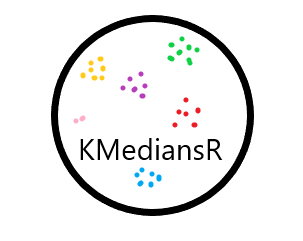The goal of KMediansR is to group a set of objects in such a way that objects in the same group (called a cluster) are more similar (in some sense or another) to each other than to those in other groups (clusters). In k-medians clustering, we partition n observations into k clusters. It calculates the median for each cluster to determine its centroid. The kmedians package performs k-medians clustering on the dataset entered by the users and returns clustered data. This can prove to be an extremely beneficial package as k-medians is more robust to outliers than the arithmetic mean(k-means).
The three main functions in the package are :
-
distancefunction- The function helps to calculate the Manhattan distance between each pair of the two collection inputs. This function takes as input
- An
mxnarray ofmoriginal observations in ann-dimensional space - An
pxkarray ofporiginal observations in ank-dimensional space It returns amxpdistance matrix. For eachiandj, the mtericdistance(u=X[i], v=Y[j])is computed and stored in theijth entry
-
kmedianfunction- A quick implementation of k-medians. It takes as input
- A 2D array of data
- The desired number of clusters It returns
- A 2D array of the medians
- 1D array of labels (the clusters the points belongs to)
-
summaryfunction- This function generates the descriptive statistics that summarize the implementation of the
kmediansfunction on the input data. It returns a dataframe that contains information about the model run such as the number of clusters, the number of points in each cluster, the inter and intra cluster distance
- This function generates the descriptive statistics that summarize the implementation of the
Simple example demonstrating the functionality of this package:
# load package
library(KMediansR)
# toy data with two clusters
toy_data <- matrix(
c(1,1,1,2,2,1,100,100,101,100,100,101),
nrow = 6,
ncol = 2,
byrow = TRUE)
# initialize the cluster centers
m <- matrix(
c(1,1,100,100),
nrow = 2,
ncol = 2,
byrow = TRUE)
# calculate Manhanttan distance between the medians and data points
manhanttan_distance <- distance(X = toy_data, medians = m)
[,1] [,2]
[1,] 0 198
[2,] 1 197
[3,] 1 197
[4,] 198 0
[5,] 199 1
[6,] 199 1
# cluster the data points
clustered <- kmedians(X = toy_data, num_clusters = 2)
[[1]]
[,1] [,2]
[1,] 1 1
[2,] 100 100
[[2]]
[1] 1 1 1 2 2 2
# generate summary results
report <- summary(X = toy_data, medians = clustered[[1]], labels = clustered[[2]])
Cluster.Label Median.Coordinates Number.of.Points.in.Cluster Average.Distance Minimum.Distance Maximum.Distance
1 1 1,1 3 0.6666667 0 1
2 2 100,100 3 0.6666667 0 1kGmedian : This is a fast k-medians clustering based on recursive averaged stochastic gradient algorithms. The advantage of the kGmedian algorithm compared to kmeans strategy is that it deals with sum of norms instead of sum of squared norms, ensuring a more robust behaviour against outlying values.
The above ideas are presented as a part of the initial proposal. However, they could be subject to change in the following milestones based on the project timeline or technical complexity.
-
R Version 3.5.2
-
R libraries:
dplyrVersion 0.7.8magrittrVersion 1.5
You can install the released version of KMediansR from CRAN with:
devtools::install_github("UBC-MDS/KMediansR")